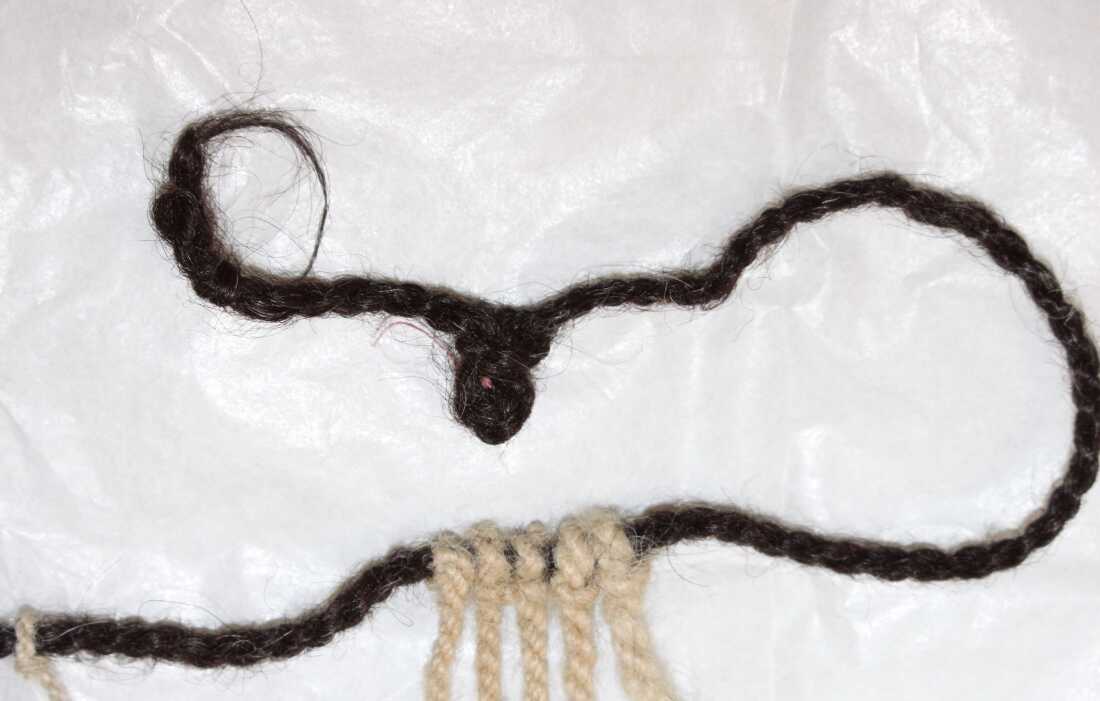A cotton and agave fiber Inca khipu is seen at an exhibit on the Smithsonian Nationwide Museum of the American Indian in 2015 in Washington, D.C.
Brendan Smialowski/AFP by way of Getty Pictures
cover caption
toggle caption
Brendan Smialowski/AFP by way of Getty Pictures
The Inca Empire in South America, probably the most highly effective pre-Columbian societies, was recognized for a lot of improvements — such because the structure of Machu Picchu, an intensive street community, and a system of terraces for agriculture. Maybe most unusual, although, was the society’s methodology of conserving data often known as khipu, which entails a system of tying knots to encode data.
It is lengthy been assumed that khipu manufacturing was the area of this civilization’s ruling elites, however a brand new evaluation of a wire made out of human hair finds that even low-class commoners might have engaged on this custom.
The invention might assist researchers rewrite their understanding of this side of Incan civilization, and propel extra scientists to check different khipus sitting in museum collections.

“The Incas had the biggest empire within the New World on the time. It lined half of a continent, just about,” says Sabine Hyland, a researcher with the College of St. Andrews in Scotland, who factors out that this large empire of tens of millions of individuals relied solely on knotted cords for conserving data.
The Inca Empire is usually cited because the uncommon exception to the overall rule that empires should have a type of written expression, says Equipment Lee, a analysis affiliate with the college, however that is solely as a result of “khipus get neglected as a type of writing.”
These uncommon recording gadgets are bunches of knots tied in lengthy, coloured cords. Usually, cords cling like pendants from one thick major strand. The Inca Empire was conquered by the Spanish in 1532, and solely a tiny share of historical Incan khipus have survived.
Just lately, although, Hyland’s college acquired a khipu, and radiocarbon courting indicated that it was from across the 12 months 1498. Hyland initially assumed it was product of hair from animals like llamas or alpacas.
However then she confirmed it to Lee. “Equipment checked out me and mentioned, ‘Sabine, this major wire is human hair,'” Hyland remembers.

The darkish brown major wire of this khipu is product of human hair.
Sabine Hyland
cover caption
toggle caption
Sabine Hyland
The researchers knew that traditionally, incorporating hair may function a type of signature that indicated who had made the khipu. And this meant that they had an uncommon alternative to seek out out extra about an historic khipu’s creator.
The hairs on this one are about three toes lengthy and characterize years of development. The researchers took samples from every finish of a strand and did a lab evaluation of components like carbon and nitrogen, to get clues about what this particular person should have eaten throughout their lifetime.

Within the journal Science Advances, they and their colleagues report that the hair got here from somebody who ate legumes, grains, and tubers. They did not see proof of an abundance of meat or maize beer, the everyday eating regimen of the ruling class.
Whereas it is potential {that a} high-ranking official may select to not eat meat for some purpose, says Hyland, it is unlikely they may get by with out ingesting a number of maize beer. “It is probably not potential to flee ingesting it,” says Hyland. “Even immediately, within the Andes, whenever you take part in rituals, you need to drink what you’re given.”

This hair evaluation provides one other piece of proof to the rising perception that khipu manufacturing and literacy may need been extra widespread within the Inca Empire than the Spanish colonizers assumed and recorded of their accounts.
This implies a relationship between the khipus of the Incan Empire and extra fashionable khipus constructed from the 1800s to immediately, says Lee.
“Fashionable khipus are typically made by lower-status individuals — hacienda staff, peasant laborers, herders,” Lee says, explaining that fashionable khipus are inclined to have a unique form and construction from historical ones. Some fashionable khipus encode agricultural data, whereas others are buried with family members in funeral rites.

“It has been fairly controversial to attract this continuity between Inca khipus and fashionable khipus, partly due to the notion that Inca khipus have been made by elites,” says Lee.
Manny Medrano, a khipu researcher with Harvard College who was not a part of this examine, says this examine is “unprecedented” in the best way it analyzed the hair.
Whereas specialists have lengthy seen human hair in khipus, he says, that is the one Inca-era one he is aware of of that has the first wire solely product of human hair. “The principle wire is actually vital in khipus,” says Medrano.
Museums maintain a whole lot of khipus which have by no means been studied by specialists, he says, and this examine is more likely to encourage a re-look at ones which have been scrutinized earlier than.
“I might not not be stunned if we discover different khipus with substantial quantities of human hair in them sooner or later,” he says, and that hair may present a technique to perceive khipu manufacturing within the Inca Empire that is distinct from the tales written down by colonizers, who might not have totally understood what was actually occurring.
“In the end, this will get us nearer to having the ability to inform Inca histories utilizing Inca sources,” says Medrano. “We have to inform a narrative of literacy and of writing and of recordkeeping within the Inca Empire that’s far more plural, that features of us who haven’t been included in the usual narrative.”









